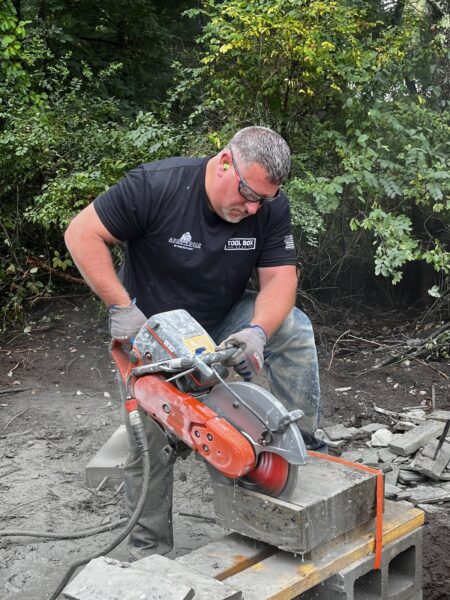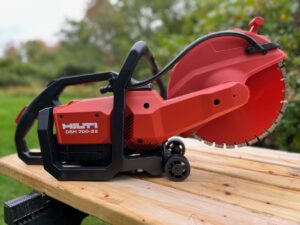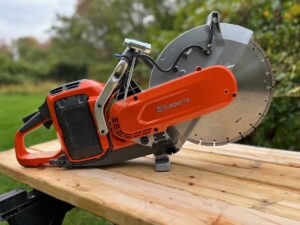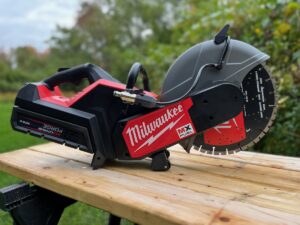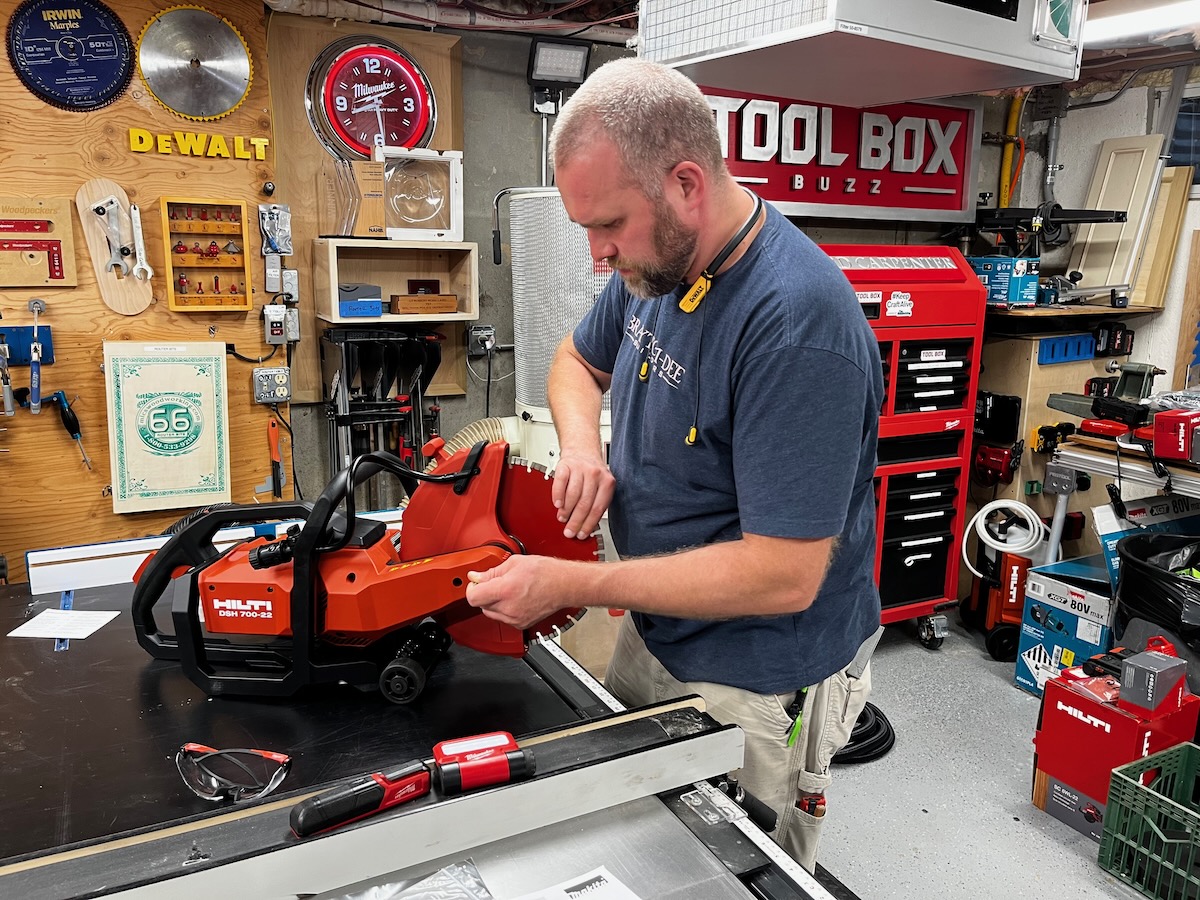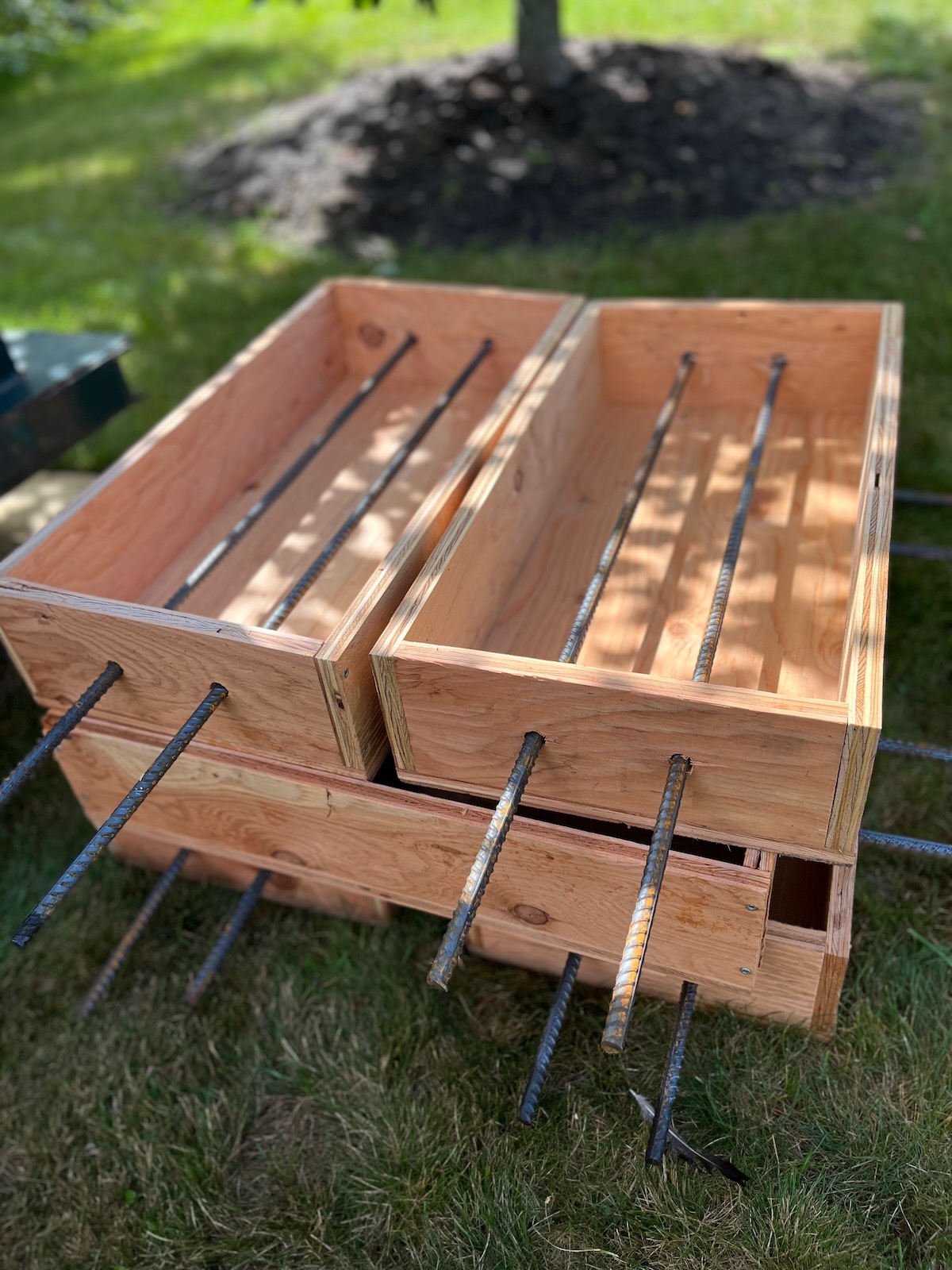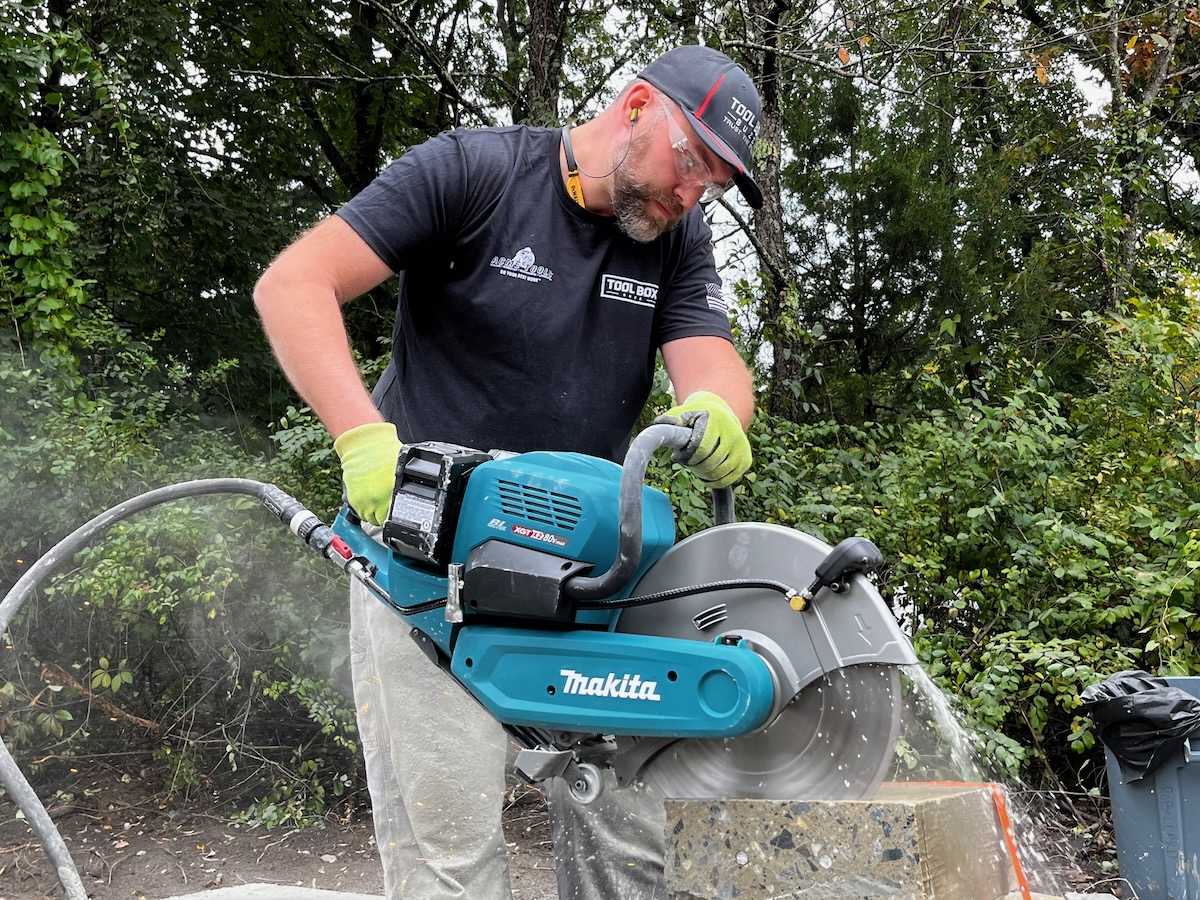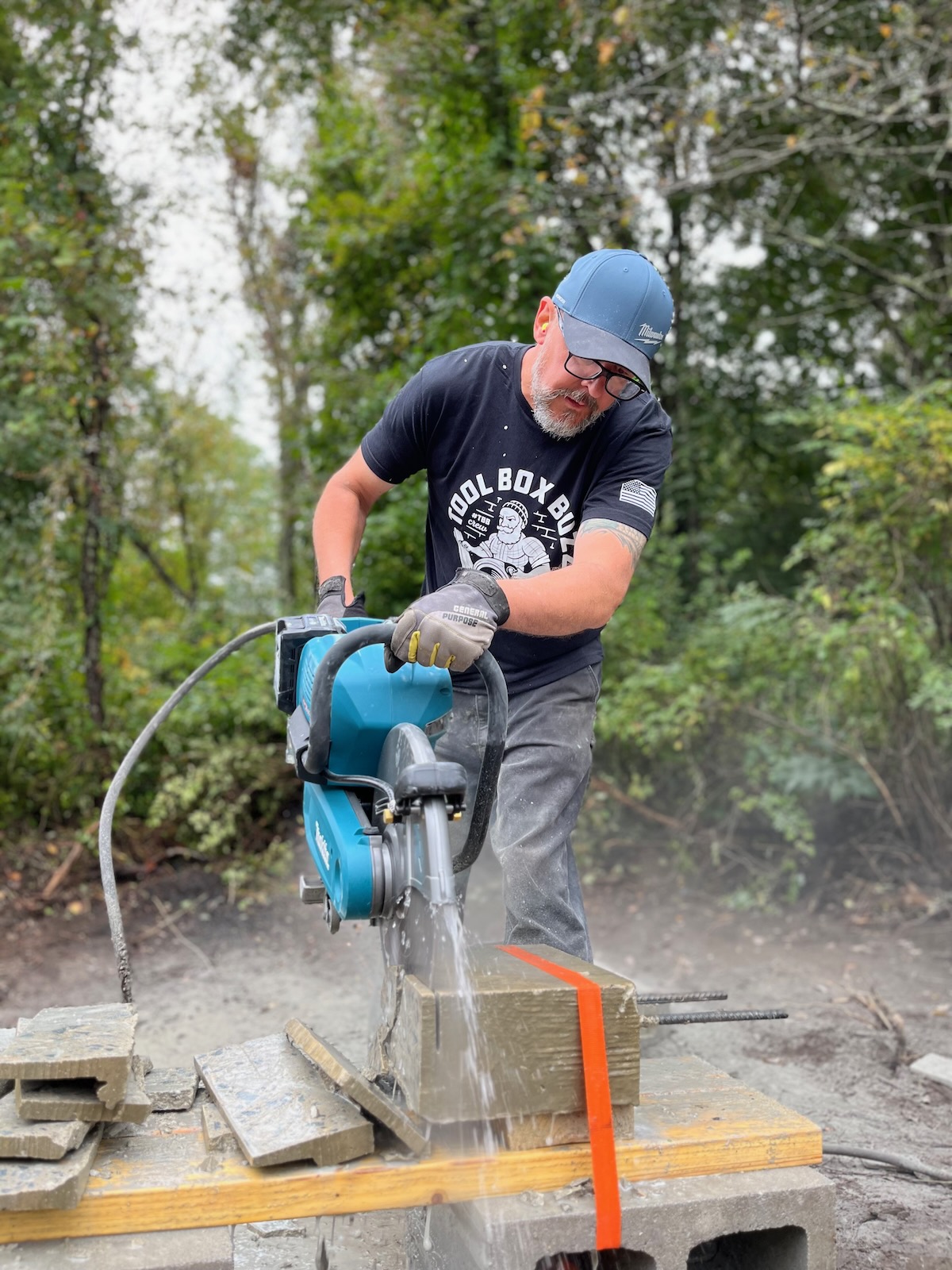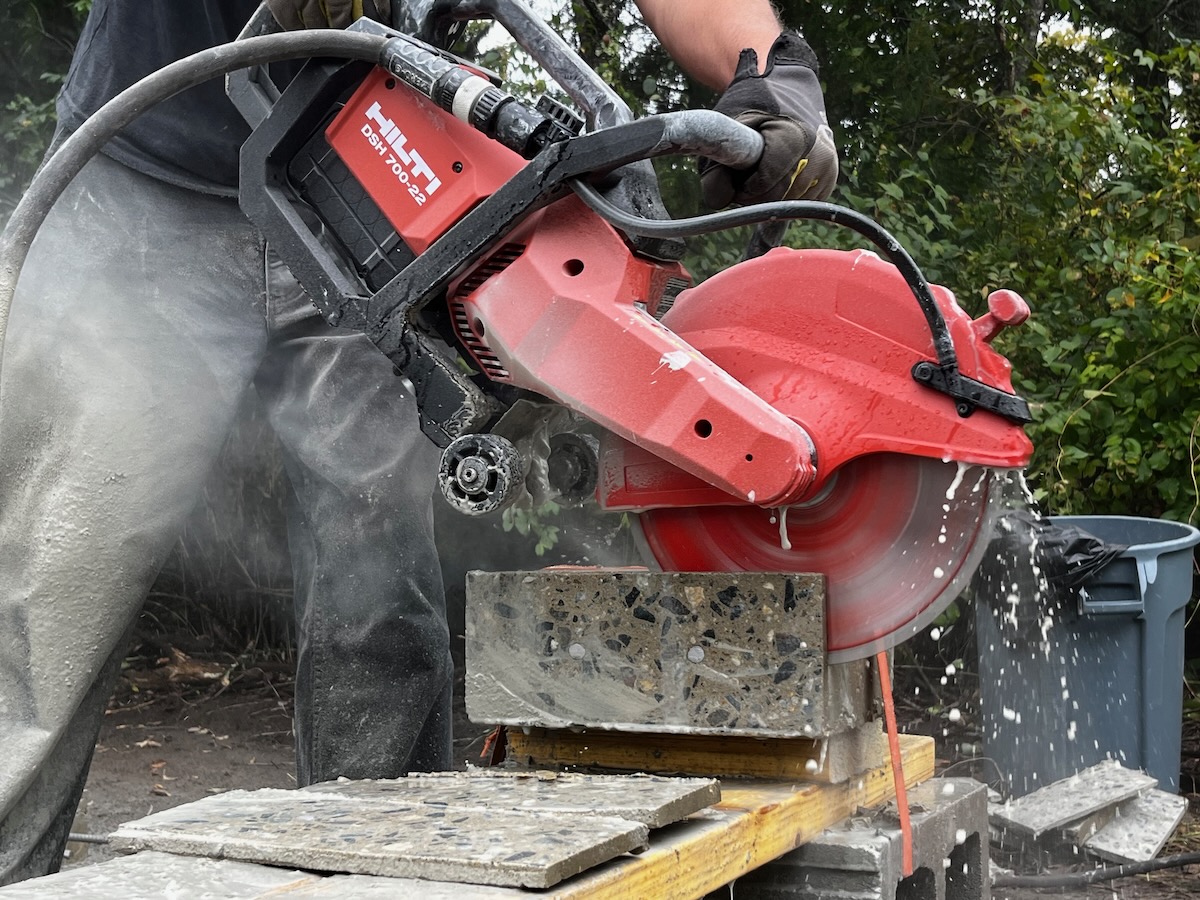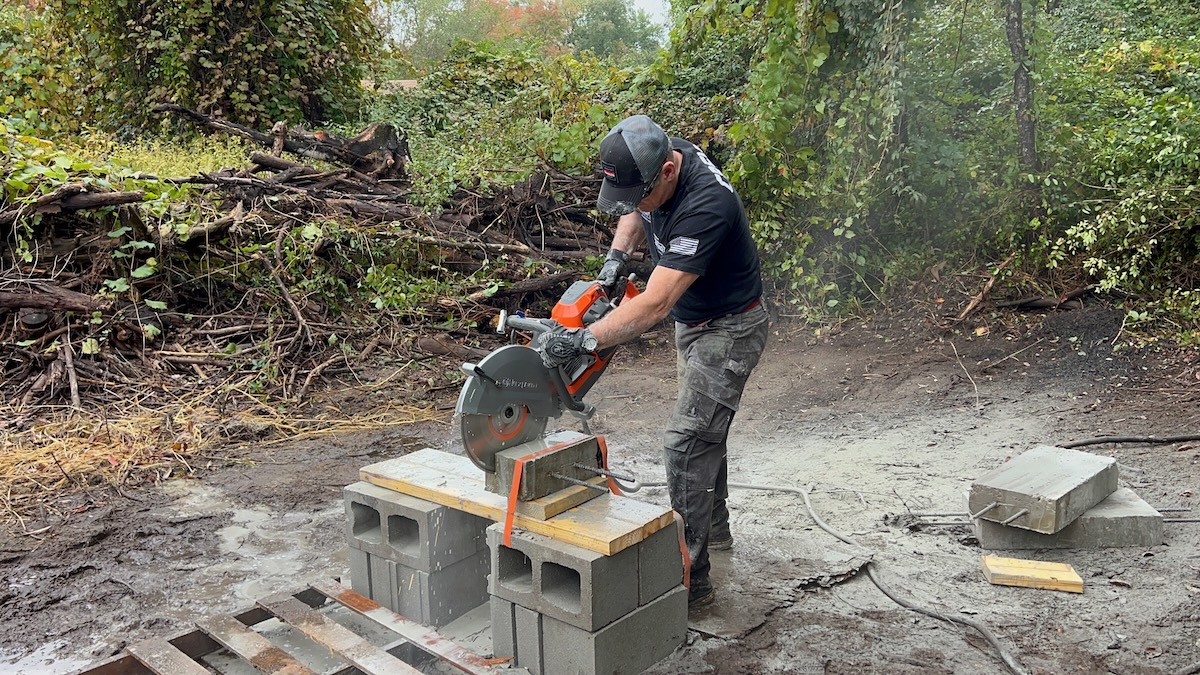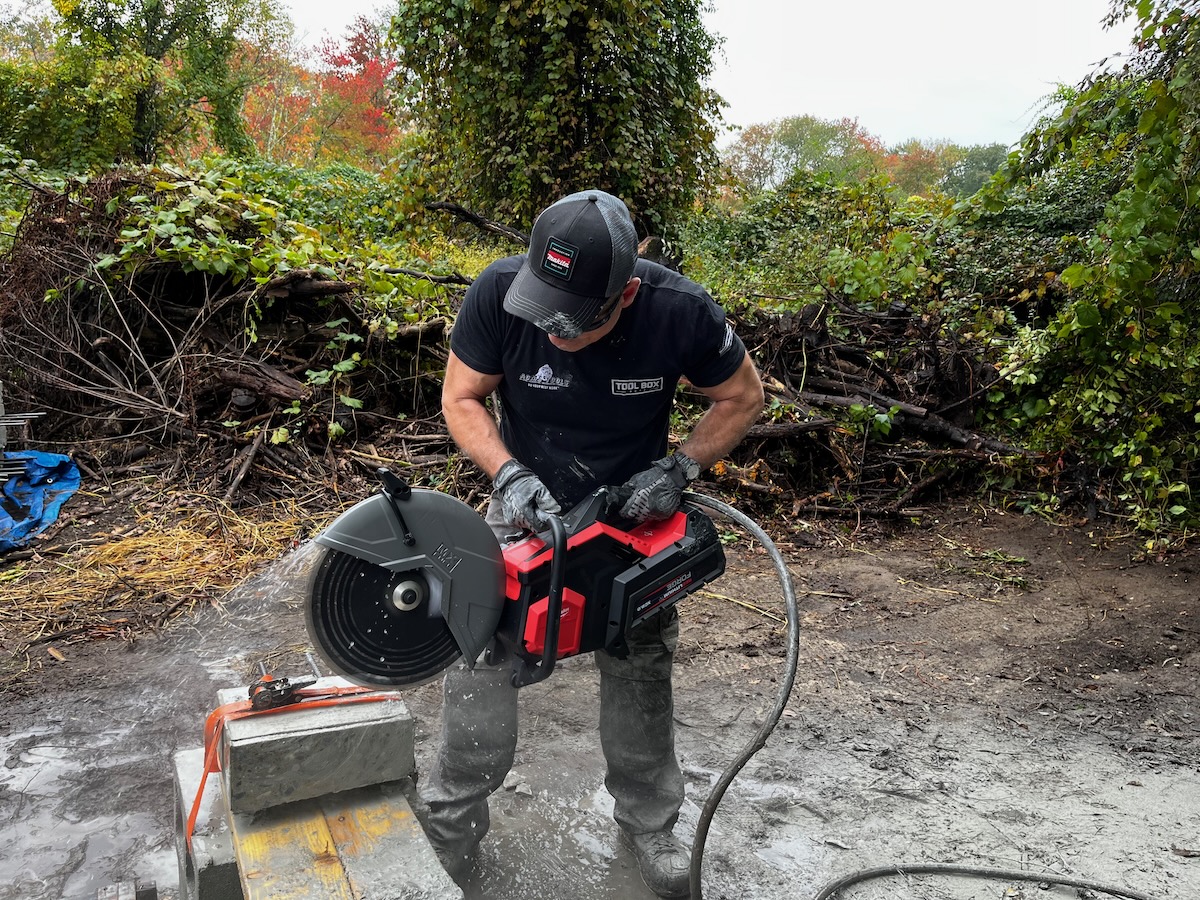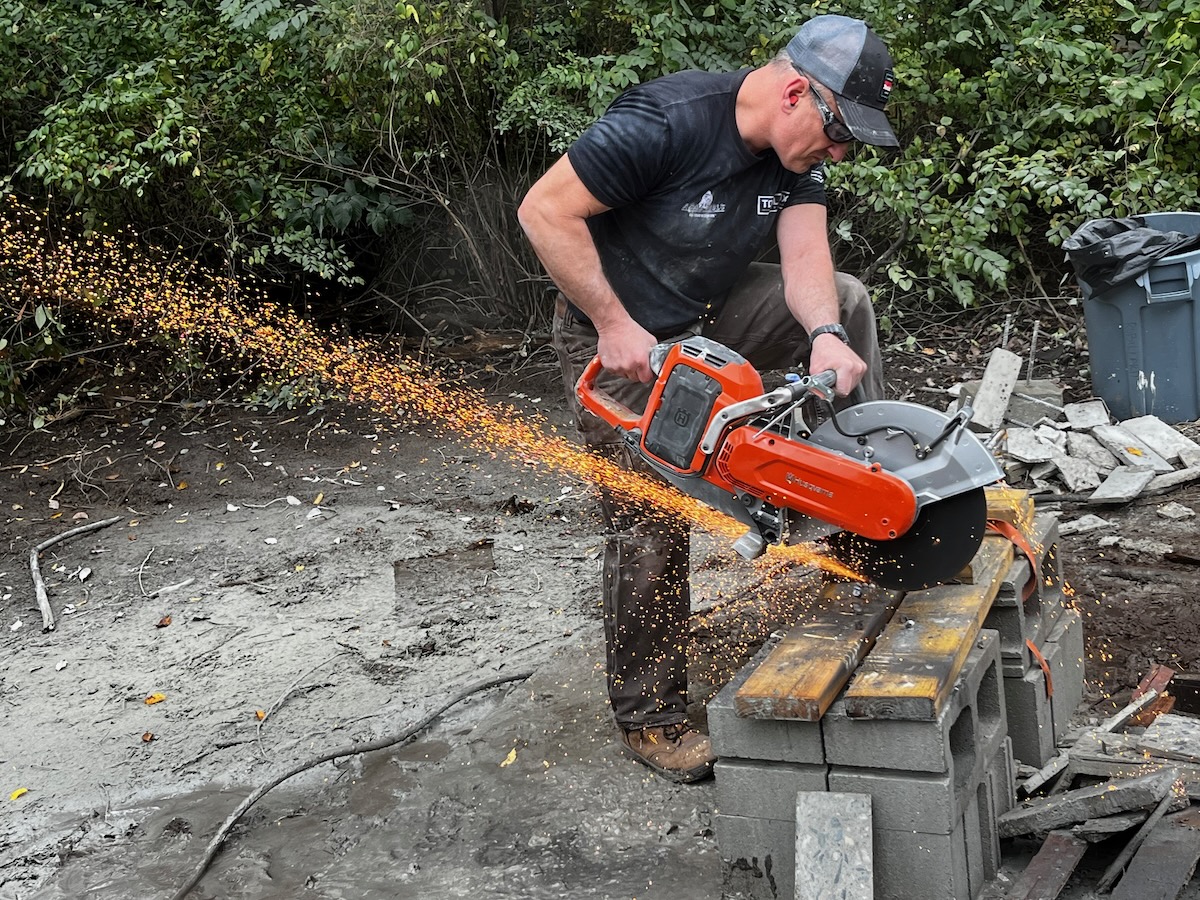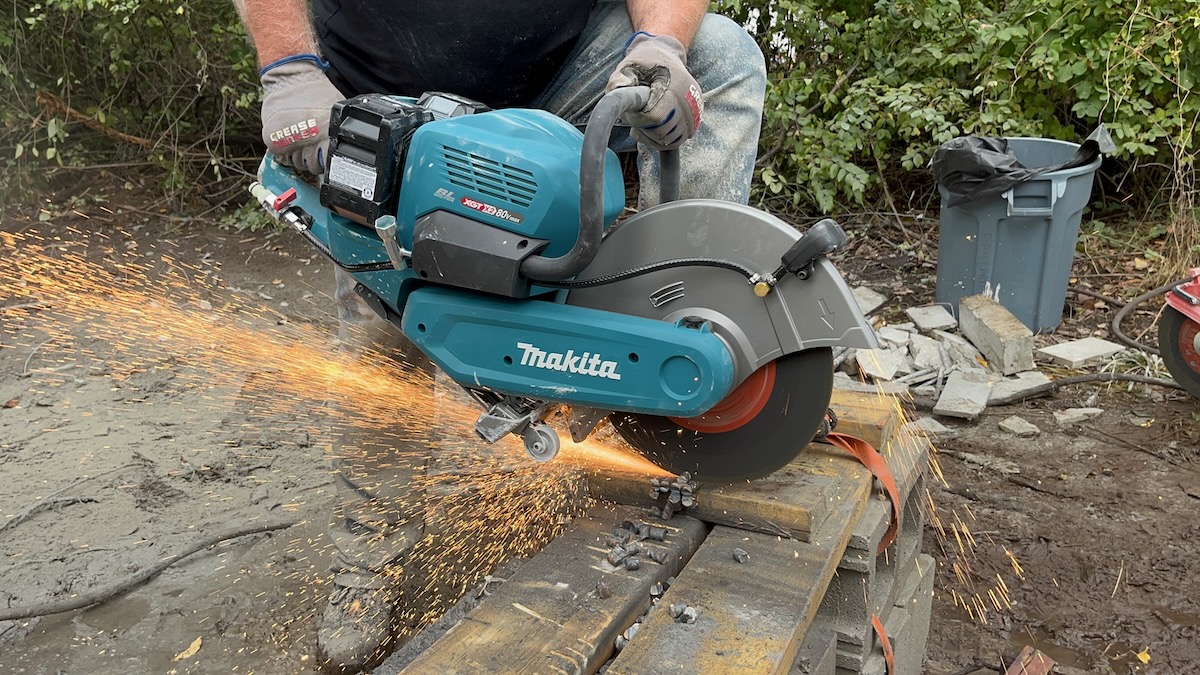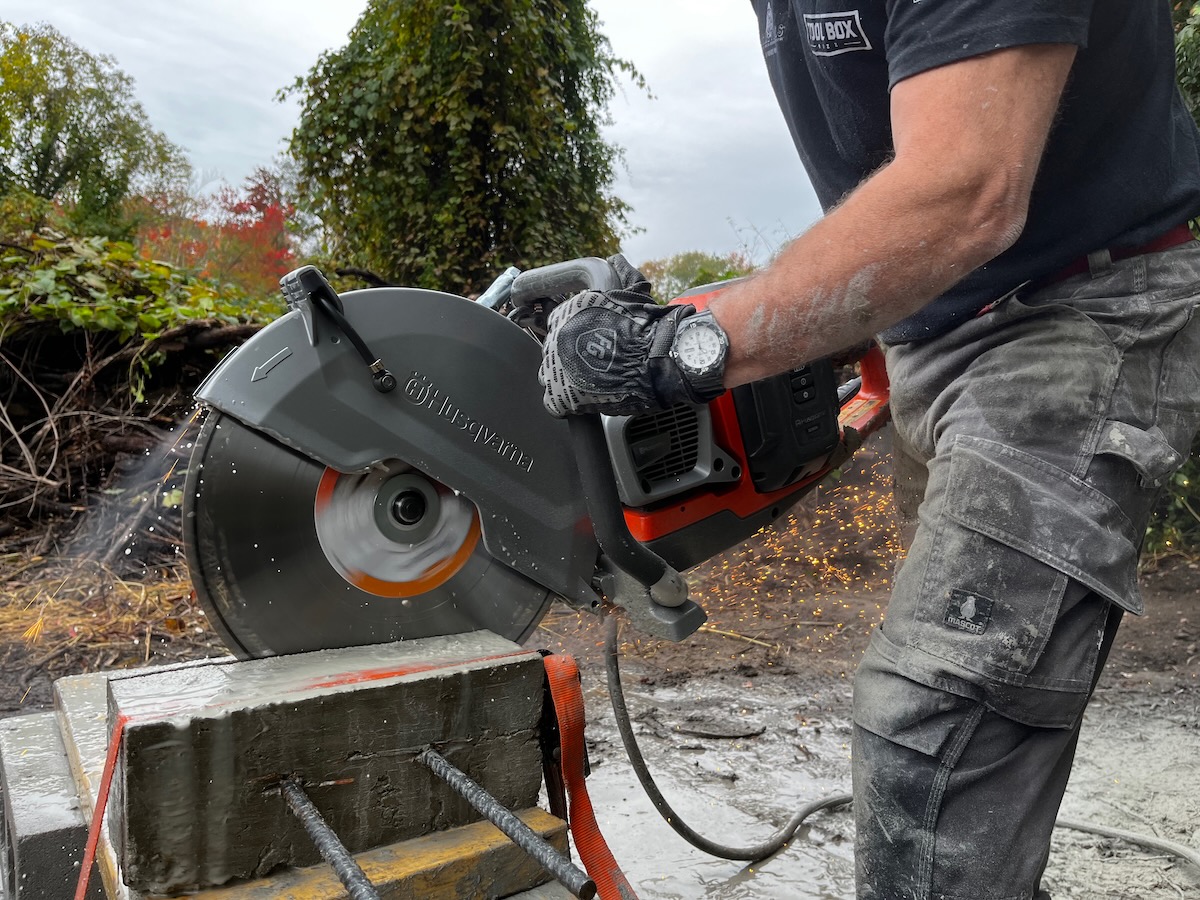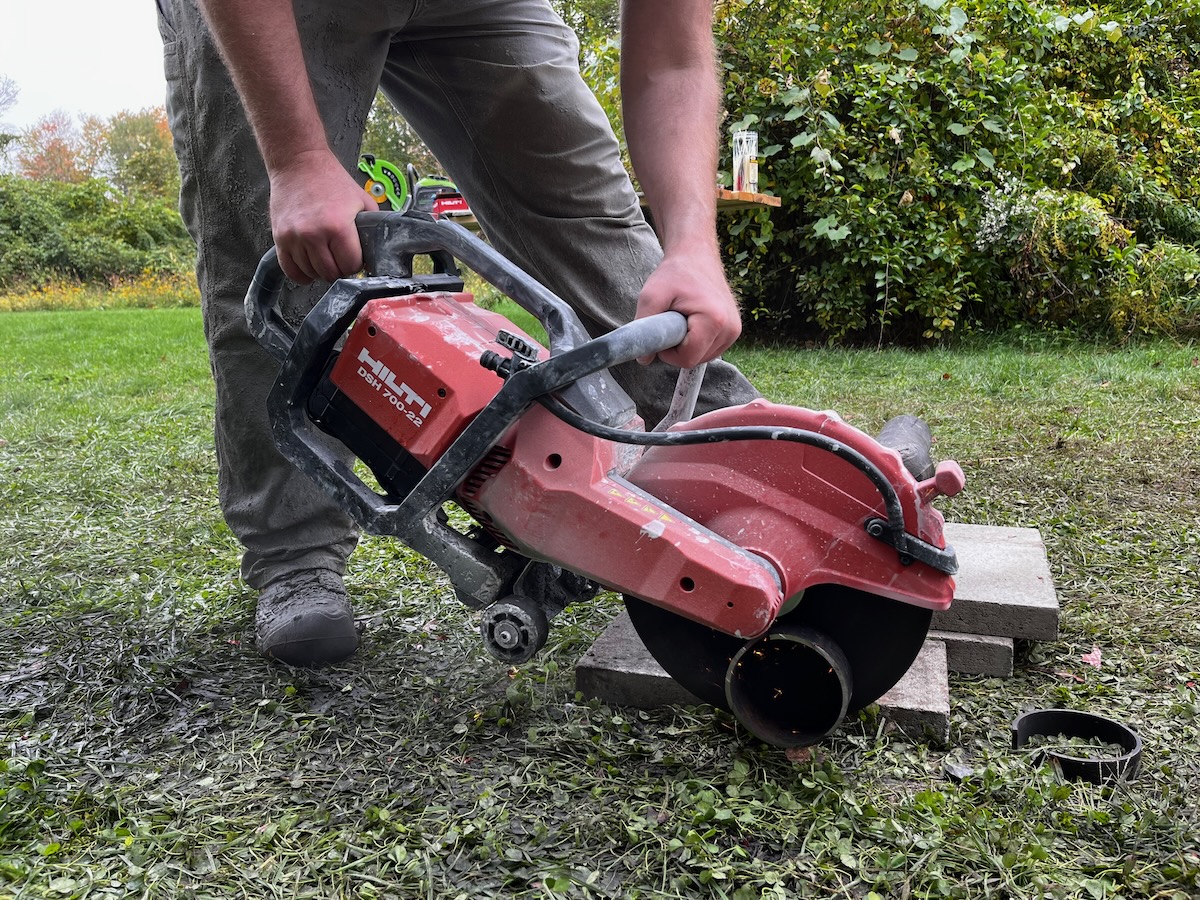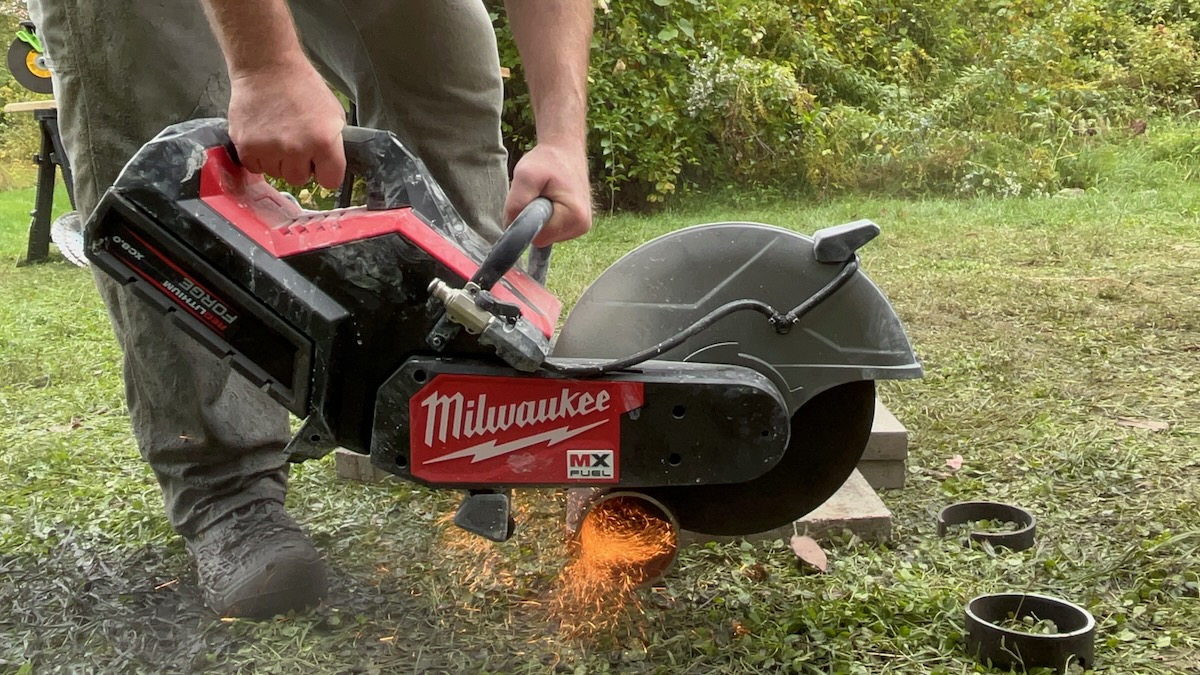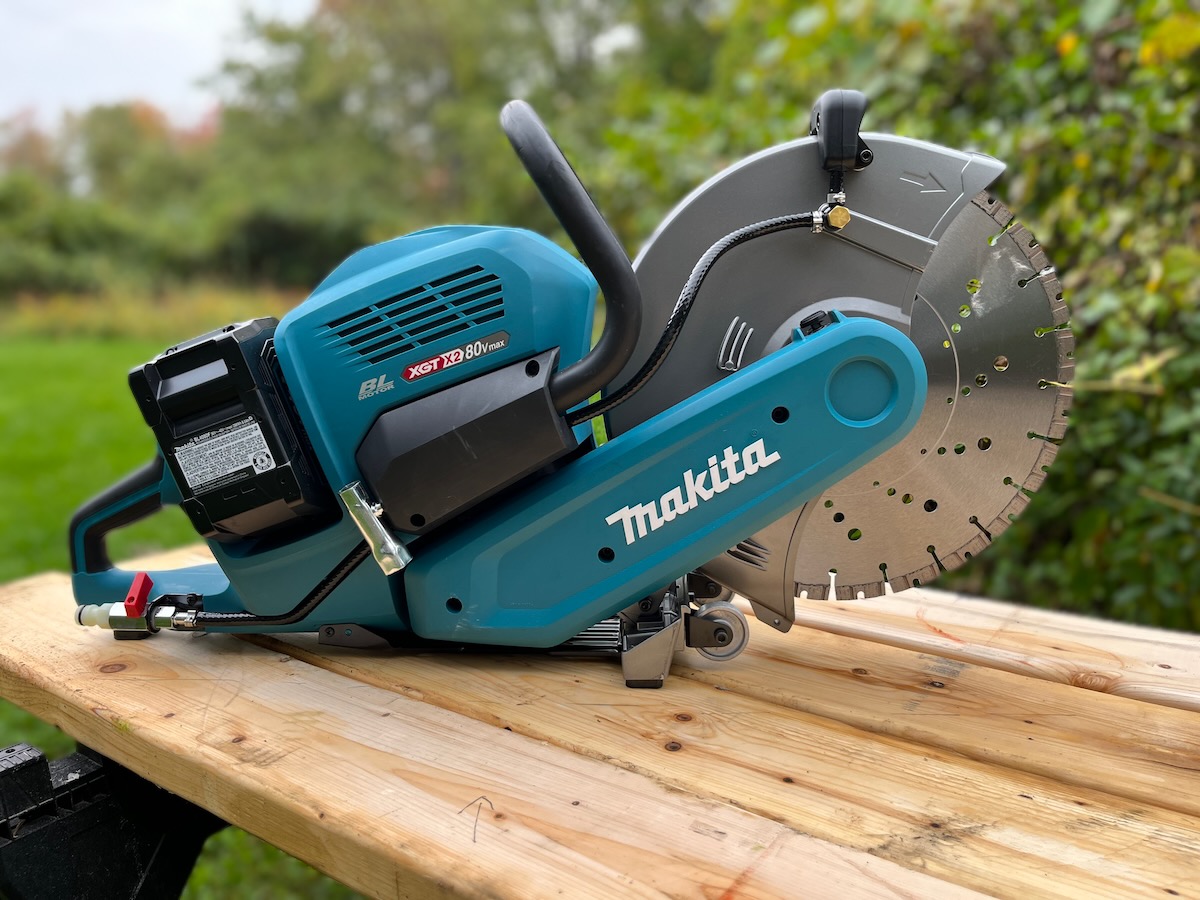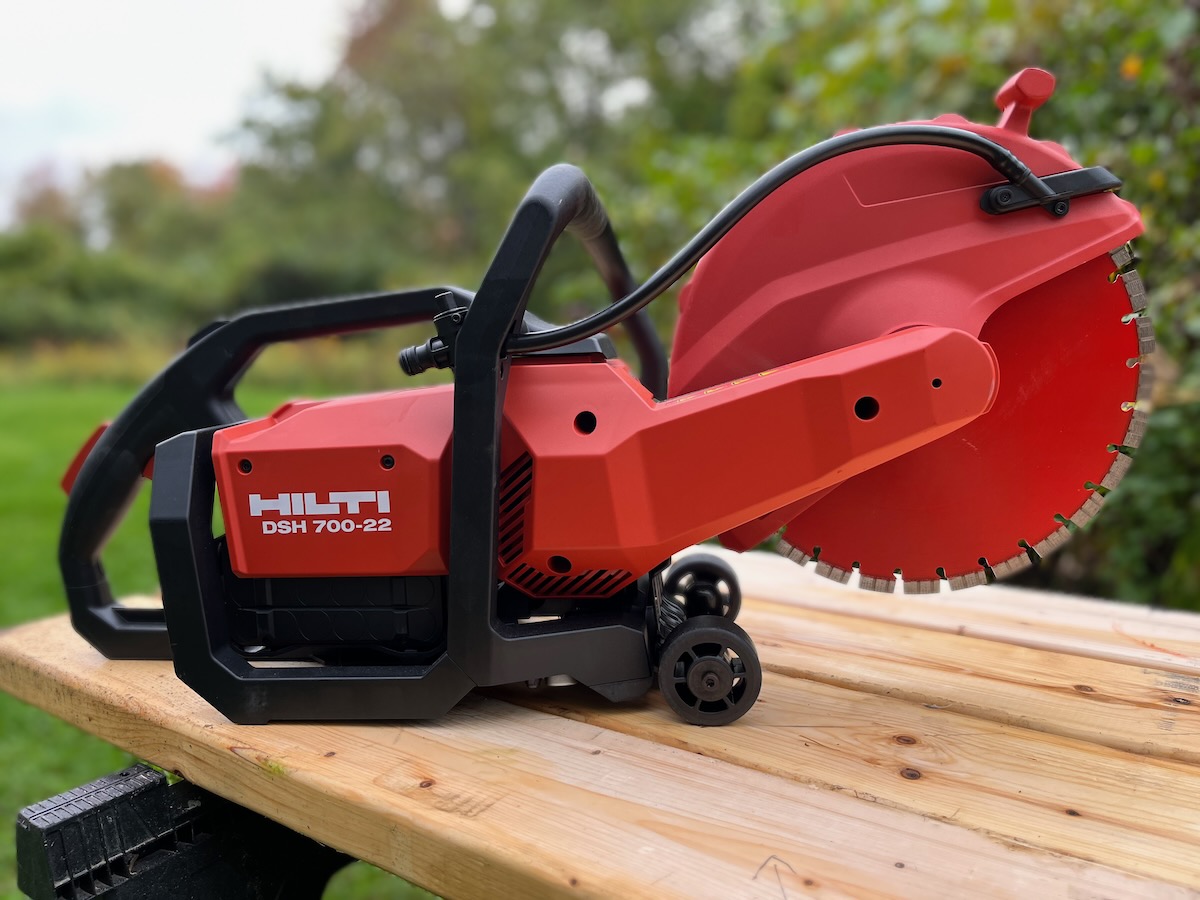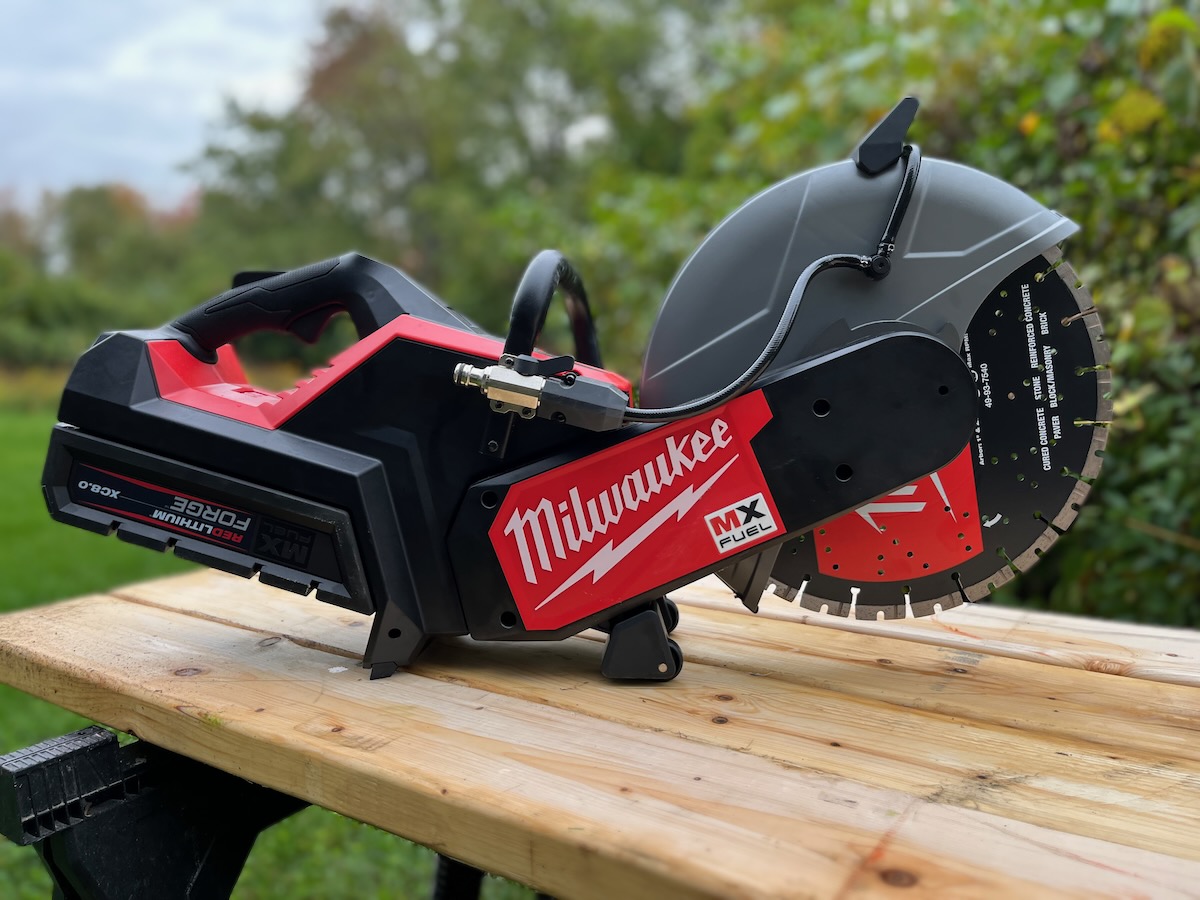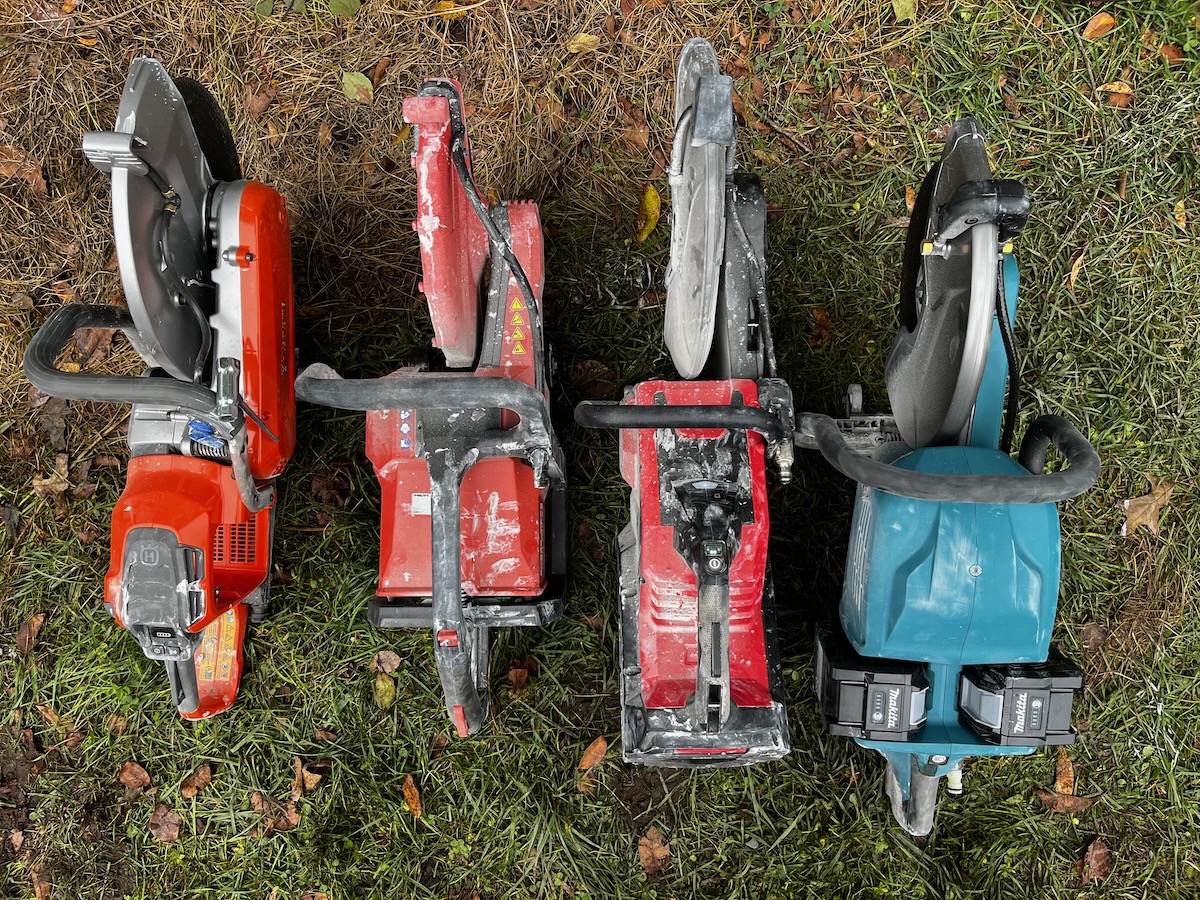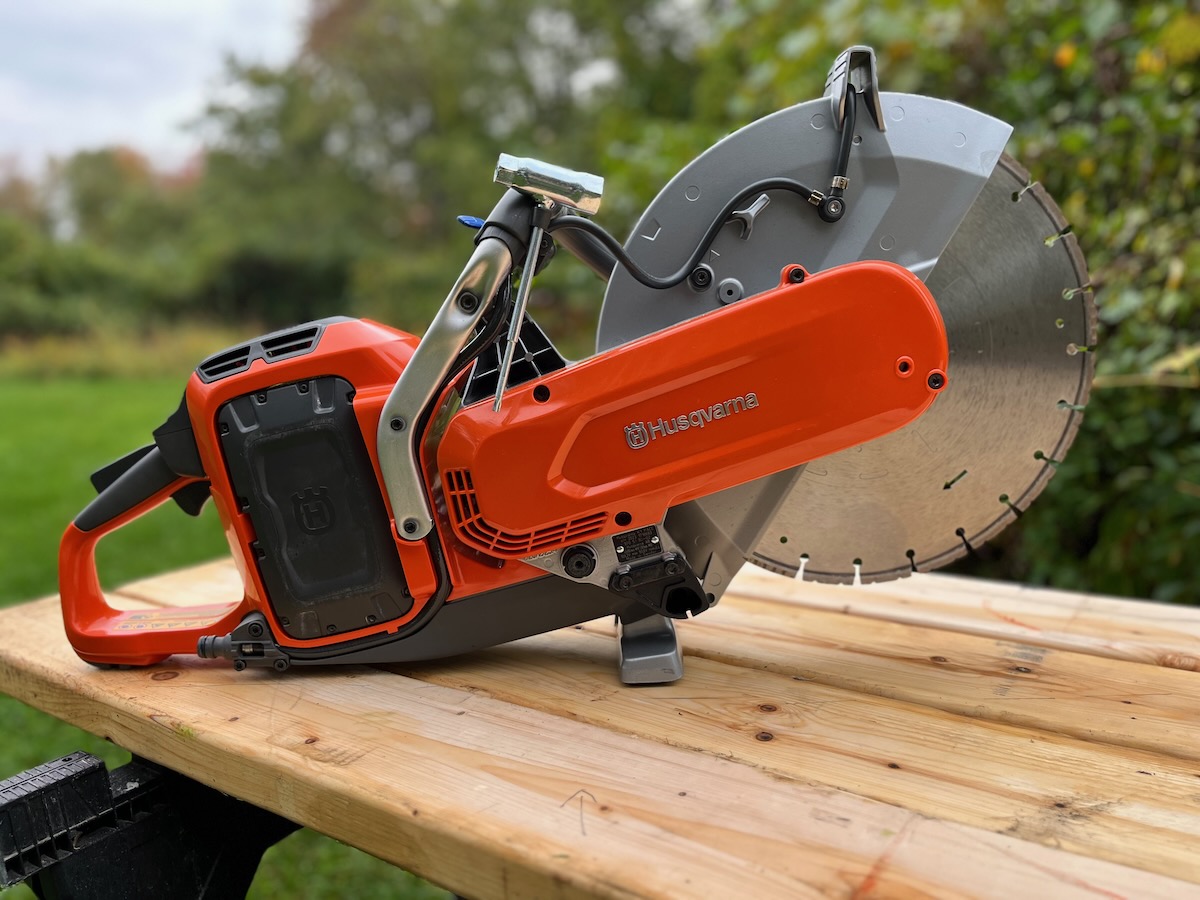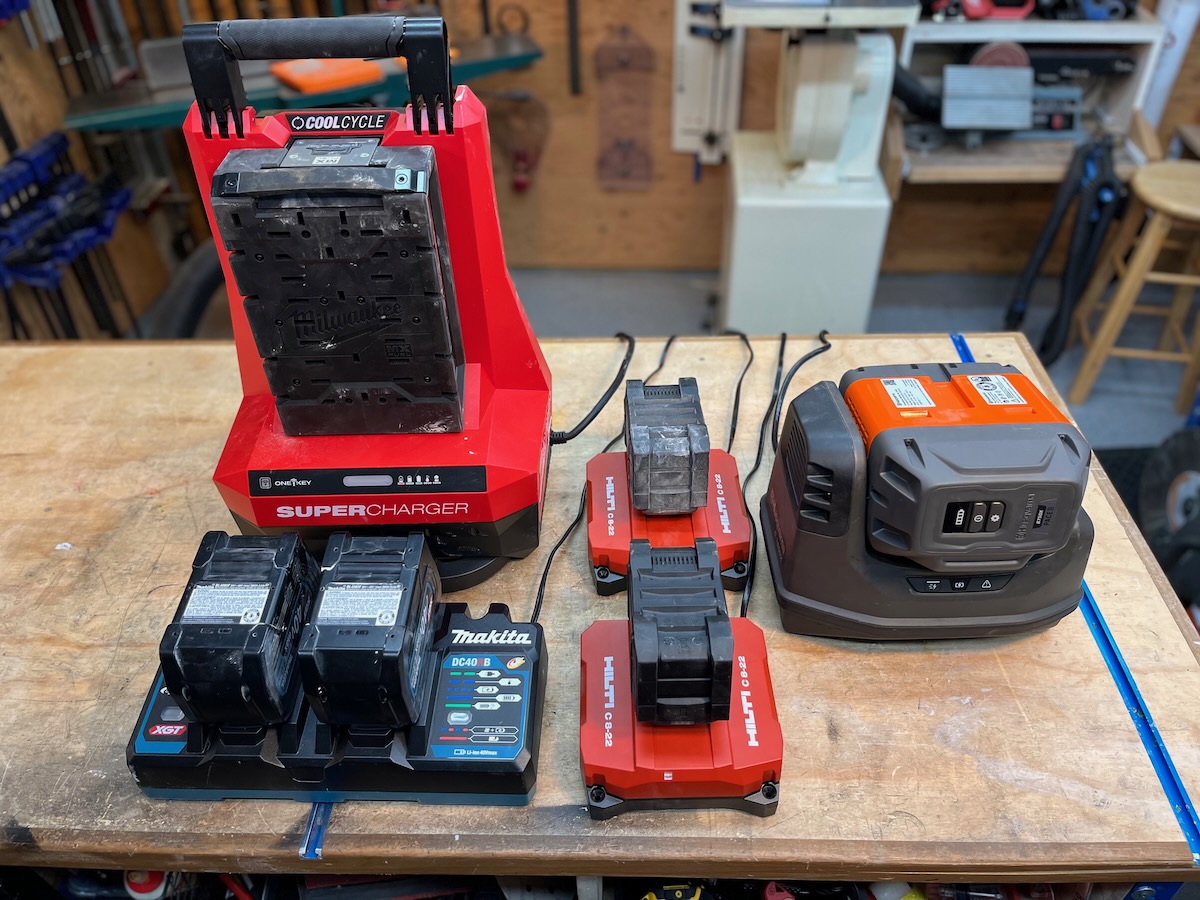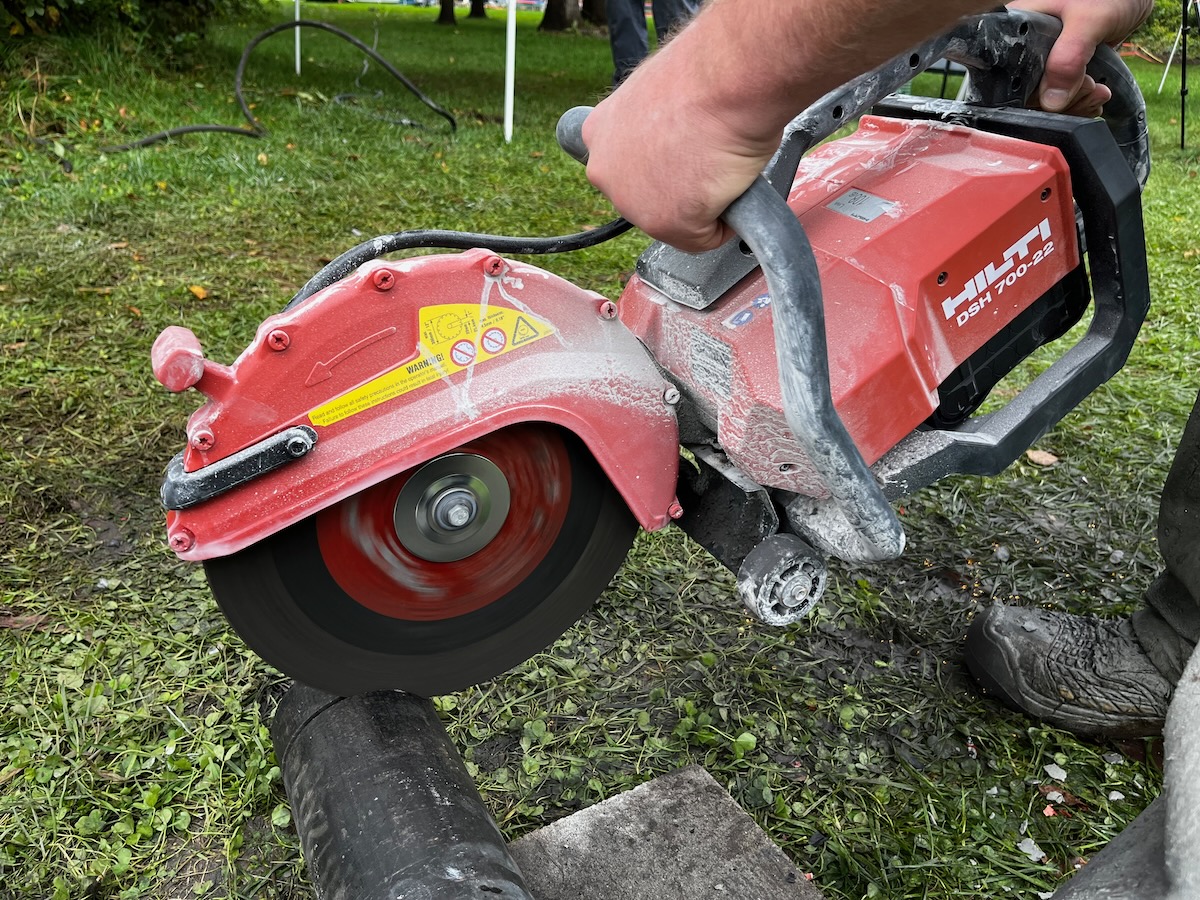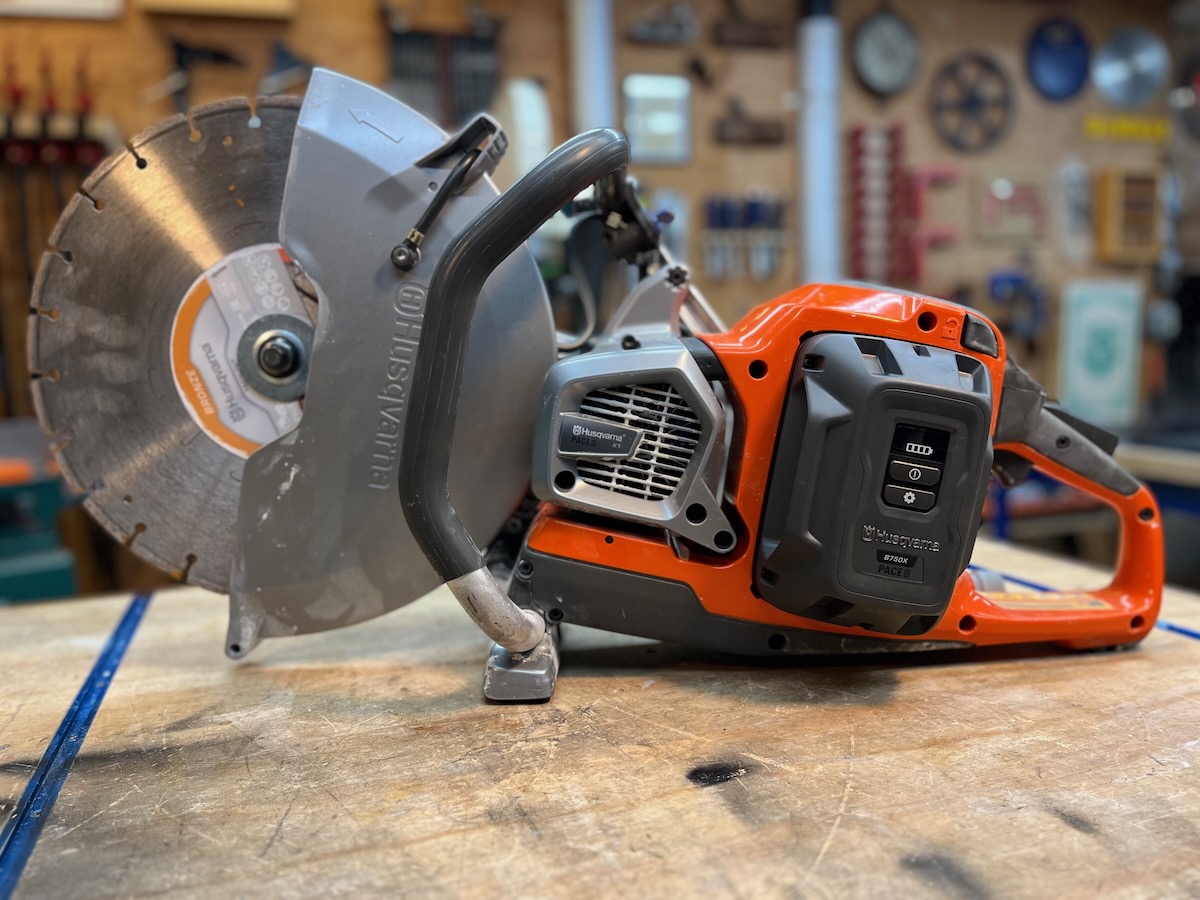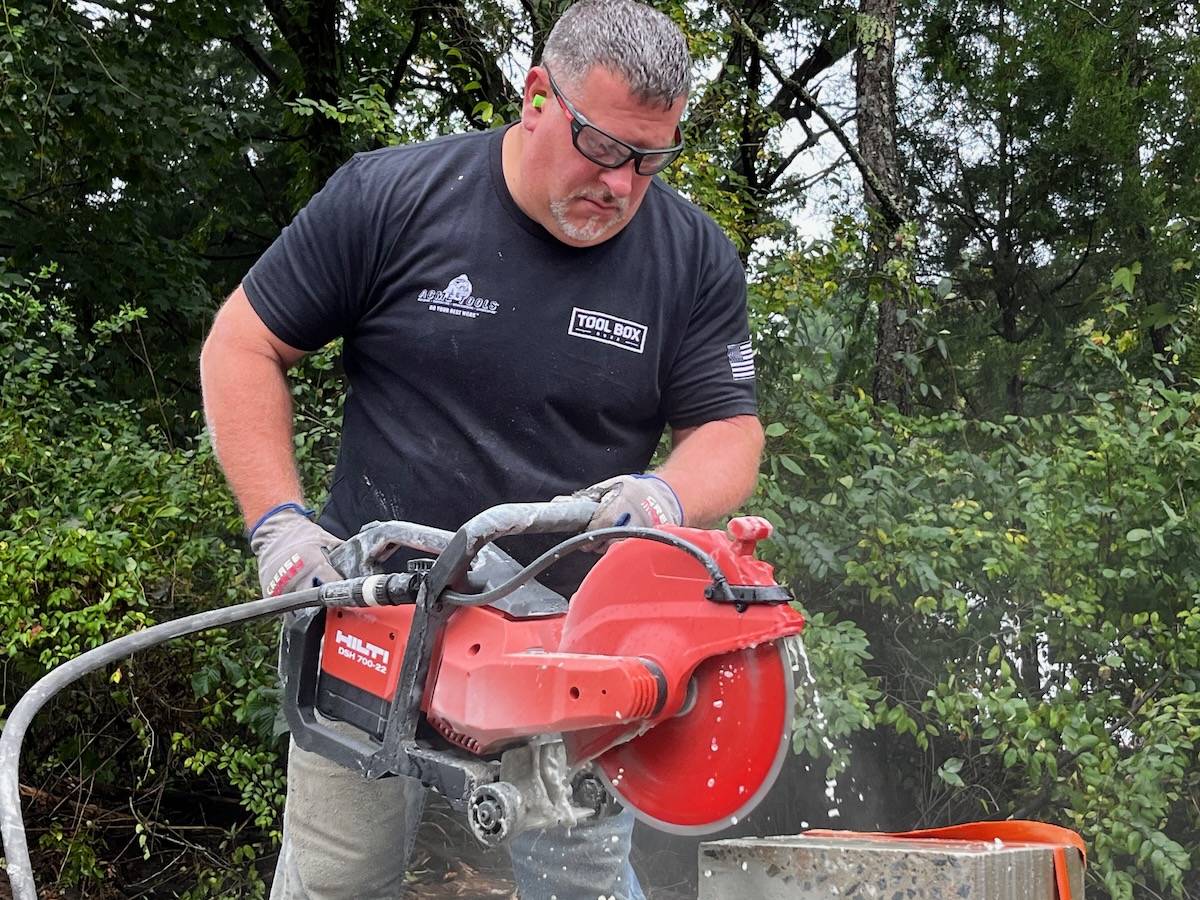Best Cordless 14″ Cut-Off Saw (Concrete Cutter) | Head-To-Head
Best Battery Powered 14″ Concrete Cutter (Cut-Off Saw) | Head-To-Head
A Concrete Cutter sometimes called a cut-off saw, masonry saw, road saw, “consaw,” or concrete saw is a hand-held tool designed to cut concrete, asphalt pavement, rebar, steel and plastic pipe. Typical uses include making openings in walls, floors, manhole structures, road surfaces, and curbs.
We all recognize that battery-powered saws require less maintenance, are easier to start, and forgo the need for the 50:1 fuel mixture.
Our industry is now experiencing an increased focus on the integration of battery-operated equipment across the job site, driving the discussion of gas tools vs. battery-powered tools. For us to even have this conversation we need to agree battery tools need to compete with gas in performance, power, and run-time.
We decided to perform a Head-to-Head test on four cordless concrete cutters (cut-off saws) to determine which one was the best saw and if these saws could compete with gas saws.
To give clarity to our testing we included the Husqvarna K770 gas saw, as a comparison standard. Husqvarna has been making cut-off saws since 1958, and we chose the K 770 because it is a powerful, all-around concrete cutter with features that make it one of the best saws on the market.
Cordless Cut-Off Saw | Line-Up
Four manufacturers sent their cordless cut-off saws and saw blades.
NOTE – The Hilti cut-off saw is a 12″ saw but was allowed to participate in this test because it has a feature called OutCut, which allows it to cut at similar depths as the other three 14″ saws. To understand what OutCut is, the arm of the saw narrows to a smaller point compared to other saws and uses a smaller diameter flange-set for use with steel core diamond blades.
Hilti
- Model – DSH 700-22
- Max Cutting Depth – 4.75″
- Weight w/ battery provided – 31.0 LBS
- RPM – 5,080 RPMs
- Blade Size: 11-13/16
- Blade: Hilti 12″ Equadist SPX 22-87947
- Battery Watt Hours – 255Wh x 2 batteries = 510 Wh
Husqvarna
- Model – K1 Pace 14″
- Max Cutting Depth – 5-5/8″
- Weight w/ battery provided – 30.8lbs
- RPM – 3,400 RPMs
- Blade Size: 14″
- Blade: S35S 14-inch Segmented Diamond Blade
- Battery Watt Hours – 749 Wh
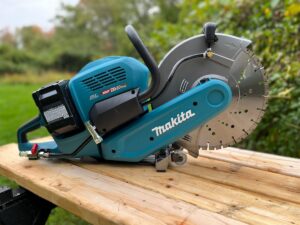 Makita
Makita
- Model – GEC01PL04
- Max Cutting Depth – 5″
- Weight w/ battery provided – 34.25 LBS
- RPM – 5,300 RPMs
- Blade Size” 14″
- Blade: 14″ Thin Kerf Diamond Blade Segmented General Purpose
- Battery Watt Hours – 288 Wh x 2 batteries = 576 Wh
Milwaukee
- XF315-2XC
- Max Cutting Depth – 5″
- Weight w/ battery provided – 33.35 LBS
- RPM –
- Blade Size: 14″
- Blade: Diamond Ultra 49-93-7540
- Battery Watt Hours – 576 Wh
Our Testing Criteria
Our team scored the cordless cut-off saws on eight criteria, each ranked independently, and the “Overall Best Cordless Cut-Off Saw” was determined using the combined test results.
We include but did not rank Watt-Hours Per Cut, and Best Value categories, but list them here for your own informational purposes. We did NOT include decibel testing since all of these saws are well over the OSHA rating for hearing protection.
Scoring Criteria – Cordless Cut-Off Saws
- Concrete Cutting Test – Most lineal feet cut in concrete with embedded rebar [Ave. speed]
- Rebar Cutting Test – Fastest cutter of five ganged #4 rebar. [Ave. speed]
- Watt-hour per cut – we include this for your reference
- Depth of Cut – Saws were ranks for cut capacity
- Charging Time – We ranked the time it took to charge depleted batteries.
- Ergonomics – Ergonomics is really important to users and an important category to consider when purchasing any power tool.
- Features – We discuss stand-out features and team favorites
- Size and Weight – Size matters and weight can get cumbersome. We measured the dimensions and scored weight of each concrete cutter as tested (with Batteries)
- Best Value – Not ranked.
- Price – The kit price at the time of publishing.
Concrete Test Blocks
We poured 3,500 psi concrete blocks, 12” x 24” x 4.5″ deep. We made the blocks deep enough for all cutter blades to be able to cut all the way through and allow ¼” for any blade wear. Each concrete block also had two embedded # 4 rebar running along its length.
Performance Testing | Concrete with Embedded Rebar Cutting [Ave. Speed]
Each cordless concrete cutter was outfitted with a fresh battery and manufacturer specific blade. All of the manufacturers insisted on us using their branded blades with their saws, claiming that the blades were designed and optimized for the saw.
Run-time on cordless cut-off saws is important when discussing how battery and gas operate differently. The number one question we are asked is, “How do these saws compare to a gas concrete cutter? In order for us to address this question we included the Husqvarna K770 gas saw as a comparison.
Run-time Test Procedure:
Without a test rig to eliminate these types of variables, it is very hard to have a controlled test. Technique is important and we recognize that we needed to let the tool do the work and not bog it down, which is why we designed our tests with the following criteria:
- All 4 battery saws had two sets of fresh batteries and new Manufacturer blade.
- The Husqvarna K770 had a full tank of gas and a fresh Milwaukee Diamond blade.
- 4 operators per saw.
- We used the 24″x12″x4.5″ concrete test blocks.
- Each cut was timed and recorded.
- Water was used on each cut.
- Each operator made 3 cuts and swapped out to prevent fatigue. [Fatigued users tend to lean on the saw]
- Every operator employed a “stepped” cutting method.
- Every operator let the tool do the cutting, and listened to the motor for feedback. Operators applied pressure when the tool would allow it, and if the motor seemed like its bogging down they let up on the pressure.
- The test ended when the saw battery died, and when the K770 ran out of gas.
- The total slices [including partial cuts] were recorded for a total lineal foot measurement.
Note – The Husqvarna K770 gas saw has a fuel tank capacity of 0.95 qt.
Note on Step Cutting:
Step Cutting, also known as incremental cutting, involves making multiple incremental cuts with the saw until the overall desired depth of cut is reached. The number of cuts taken to reach the desired depth depends on the material being cut, the saw’s horsepower, and the operator’s experience.
- Step Cutting Increases Cutting Efficiency
- Step Cutting Increases Blade Life
- Step Cutting Results in Cleaner, Straighter Cuts
Note on Run-time Testing
With any cut-off saw you will experience varying results based on the material you’re cutting, you’re cutting style, operator experience, blade used, etc. Ambient temperature also affects run-time. The more demand you put on the motor, for example leaning into the saw too much, the more Amps it will pull from the battery to keep the power output. The same effect can happen with a gas saw, except run-time is just not usually taken into consideration given the quicker refueling vs. recharging time.
Run-Time Testing | Winner – Husqvarna
In all cases, it is necessary to supply two sets of batteries in order to compete with the expected run-time of a single tank of gas, on a gas saw. Manufacturers recognize this, and most are starting to sell these saws as a kit with two sets of batteries
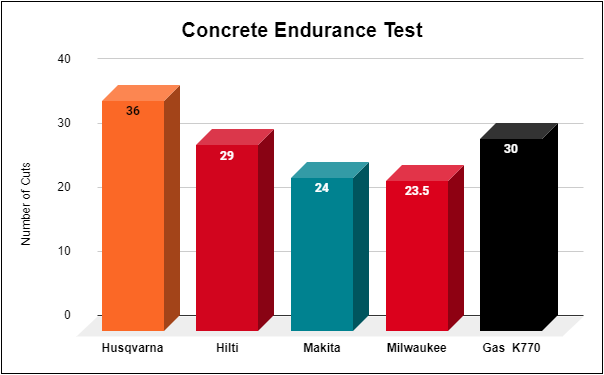
The Husqvarna concrete cutter was able to complete 36 cuts, or 36 linear feet, in the concrete blocks, compared to the K770 gas saw which completed 30 cuts (30 linear feet). Second place was the Hilti cut-0ff saw with 29 cuts (29 linear feet), followed by the Makita with 24 cuts (24 linear feet) and Milwaukee with 23.5 cuts (linear feet).
One interesting fact was the average speed to complete these cuts.
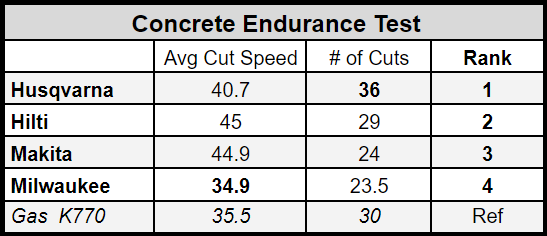
The gas K770 saw completed 30 cuts [30 lineal feet] with an average speed of 35.5 seconds. The Milwaukee which brought up the rear with the least amount cut, was powerful enough to cut the concrete blocks even faster than the gas saw at 34.9 seconds. The Husqvarna cut an average of 40.7 Seconds and both the Hilti and Makita tied with 45 seconds.
Note – photos in this article show K1 Pace with a smaller battery. This saw was photographed, and tested with a smaller battery, and later that week, tested again with a larger battery. The stats in this article are from the larger battery.
Watt-Hours Per Cut
While many sectors of the power tool industry have transitioned to battery power and cut the cord, there remains some specific tools like cut-off saws (concrete cutters) where there is no cord to cut. Instead the power source is a small engine that runs on gas. In order for the cordless cut-off saws to compete with the gas power standards, they need to not only have similar cutting power but also carry enough potential energy on board to get the job done.
With all the tools running at different voltages, the quickest way to get a snapshot of how big a “gas tank” the tool has is to see how many Watt-Hours the batteries on board have. We ran our endurance test with one battery swap so Watt-Hours are doubled in the chart. By calculating Watt-Hours per cut we can get a good idea of how efficient the tool is at transforming that battery potential capacity into concrete cut.

The Husqvarna had the largest battery of the group which helped it achieve top rank of cuts. But it was also the second most efficient at using its “gas tank.” The Hilti had the least amount of Watt-Hours but cut the second most amount and was a standout as the most efficient with 35.17 Wh/cut.
The Makita and Milwaukee have exactly the same Watt-Hours on board and cut almost an identical amount concrete. The Makita edged out a half cut over the Milwaukee which translates to a lower Wh/Cut value of 48.00.
An interesting observation when comparing the efficiency ranking of the tools is to compare them to the following speed and power rankings. It’s clear there are always design tradeoffs between power and efficiency and these tools are no exception.
Performance Testing | Rebar Cutting [Ave. Speed]
Each cordless cut-off saw was outfitted with a fresh battery and the same brand specific abrasive cutting disk. One operator was used to make three cuts in five ganged #4 rebar for an average time.
Speed Test Procedure:
- The same operator and timer teamed up to make 3 through cuts in five #4 rebar.
- Each cut was timed separately.
- The operator pushed as hard as the saw would allow.
- The three cuts were averaged and scored.
Fastest Rebar Cutting | Winner – Milwaukee
The Milwaukee was able to cut through five #4 rebar in. 7.78 seconds. Second place was the Makita at 10.3 seconds, and third was Husqvarna at 16.4 seconds, Hilti fourth at 17.0 seconds.

The team felt that this test, with all of the saw using an identical blade, was a great indicator of the available cutting power.
Depth Of Cut | Winner – Husqvarna
The depth of cut on a saw is important to all users. Husqvarna had the deepest depth of cut with 5-5/8 inches. Second place was the Makita and Milwaukee both with 5 inches, followed by the smaller Hilti saw at 4-3/4″. Husqvarna’s unique design where the arbor is offset from the drive band allowed for this impressive cutting depth.
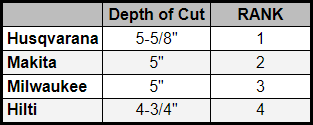
Power Cutter Ergonomics | Winner – Husqvarna
The ergonomics evaluation in this section is purely subjective and based on the opinions of the testing crew. After a full day of running performance tests, the team sat down and ranked each tool in several categories on a score of 1-4 [1 being the best]. For the ergonomics evaluation, the team evaluated the following criteria:
- Grip
- Balance
- Line of Sight
- Vibration
- Blade change
- Battery change
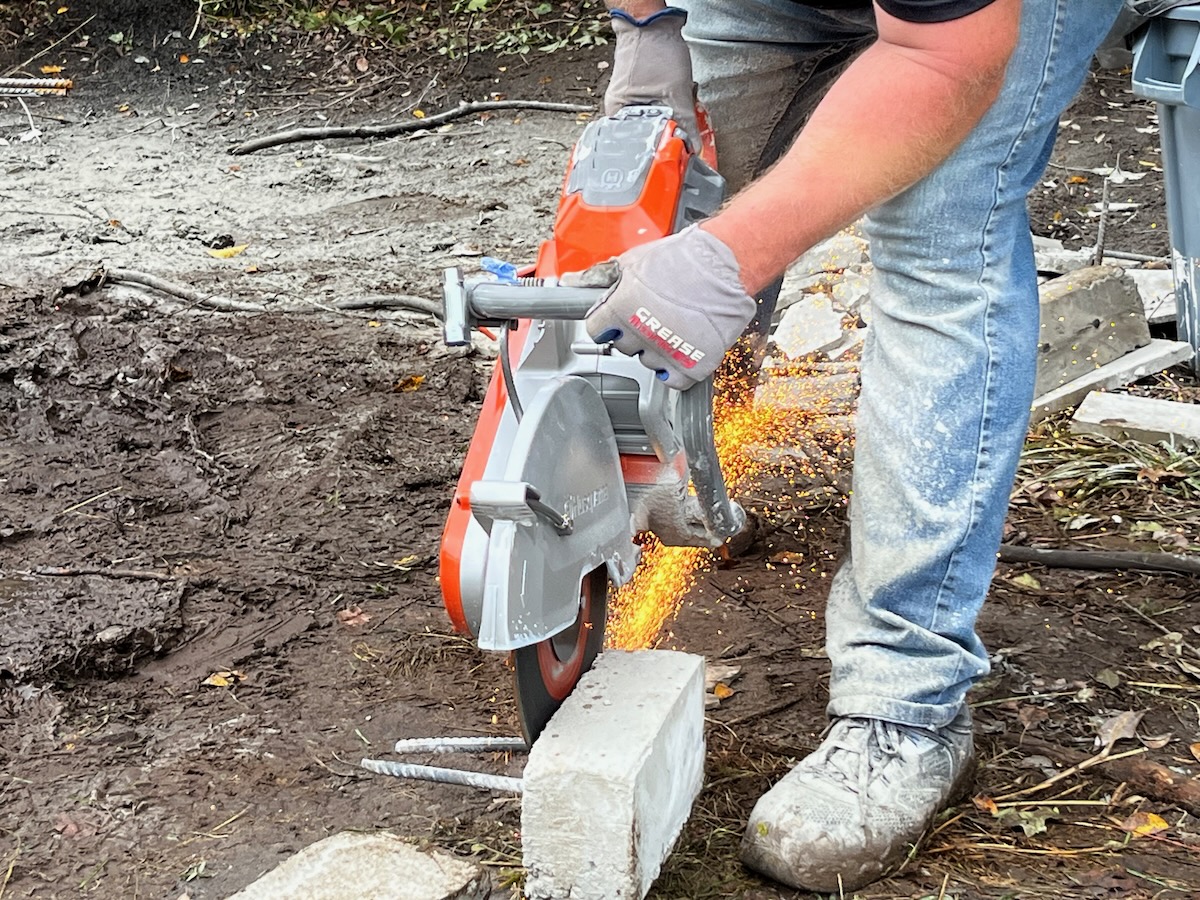

The Husqvarna was the clear winner and a team favorite with final ergonomic score of 9. It won three categories with top score for grip, balance and line of sight.
The team did not like that the Husqvarna does not have rollers but all agreed that it had excellent vibration damping, excellent balance, was the smoothest cutting and its streamlined design contributed to its excellent line of sight. It was very obvious to the team that Husqvarna has been making these cutters for a long time, and the form factor of their battery powered and gas powered saws is very similar.
Second in ergonomics was a tie between the Hilti and Milwaukee. Hilti took tops in vibration, and scored second in balance. Milwaukee came in second in grip, line of sight and blade change.
The team liked the Hilti grip and balance and felt it had a really good line of sight. All of us felt that it was a smooth cutting saw and was one of the easiest saws to start and operate. The only criticism was that the batteries tucked under the tool and are not as easy to insert or remove compared to the others.
Milwaukee is a powerful cutting saw that you can lean on. It has a nice grip, excellent line of sight, great balance, good battery removal but is a bit bulky and heavy. The Milwaukee saw has no visible decoupling but had surprisingly low vibration. Milwaukee does isolate the drive systems gear box to minimize vibration.
Makita which scored tops in blade change and had very easy battery changes. However its bulky size, weight, and uneven balance hindered its ergonomics score. The Makita had the easiest blade change, was a super powerful saw, it was the only saw that you never had to back off on while cutting.
While cutting concrete the Makita seemed to vibrate quite a lot. However when more force was applied the vibration lessened considerably. Basically the user was forced to “preload” the decoupling spring to prevent blade chatter. This seemed to be a non-issue in rebar cutting and led us to wonder if it was due to the blade more than the saw itself.
Cordless Concrete Cutter Features | Winner – Hilti
We considered 8 features on these cut-off saws:
- Tool Activation
- Water connection
- Decoupling [vibration]
- Blade Brake
- Wheels
- Handles [Multiple Hand Placement]
- Indicator Light
- Arbor Lock
- LED Light

Hilti took first place in features with a top score in tool activation, blade brake, had the best wheels, and second best water connection. Second place went to the Makita with a well designed arbor lock, water connection and the only saw to feature an LED light. Third place in features was a tie between Husqvarna and Milwaukee.
Husqvarna has an electronic brake called “X-Halt,” which stops the blade in a fraction of a second if a kickback occurs. The function cannot fully prevent personal injury from a kickback, but it decreases the risk.
Husqvarna had the most informative user interface, great decoupling and tool activation. It will also time out [turn off] after 3-minutes, a time period we feel is too short.
Makita had the best auxiliary handle in terms of the amount of usable space or hand positions. It is also the only tool in the test to feature a push-button arbor lock.
Makita is equipped with “Active Feedback-Sensing Technology,” which electronically turns off the motor if the rotation of the cutting wheel is suddenly forced to stop. It also features Extreme Protection Technology, which is engineered for improved dust and water resistance.
No one on the team liked how the Makita lock-off button is actuated. This single-sided safety switch [set up for right-hand thumb] is difficult for left-handed users to activate. Instead of a safety switch integrated into the palm grip which naturally gets depressed when holding the tool the users must push this button with their thumb 90 degrees offset to the spine of the tool. It’s neither intuitive, nor comfortable to actuate, and we all fumbled with it.
Milwaukee had a fantastic blade brake, and incorporates their RAPID STOP™ technology to help prevent damage from kickbacks and unexpected handling behavior. It has a unique trigger activated water valve which turns on or shuts of the water with the trigger. This initially received high praise from the review team but later in testing proved to be a hindrance due to erratic behavior likely due high water pressure.
The Milwaukee states in the manual that the MAX water pressure for the tool is rated for 60 psi. We measured 97 psi at our test site. Milwaukee needs to address this, as contractors do not want to add an additional accessory, like a pressure reducer, to their set up.
Bluetooth Functionality
Husqvarna has built-In connectivity for asset management, allowing you to monitor location, run-time, service intervals and receive wireless updates.
Milwaukee has One-Key connectivity which allows for fleet management, location tracking and lockout.
Power Cutter Weight | Winner – Husqvarna.
Weight can cause fatigue with cut-off saws. The lightest saw was the Husqvarna weighing in at 30.8 lbs. Second lightest saw was the Hilti at 30.1 lbs, third went to Milwaukee at 33.35 followed by Makita at 34.25 lbs.
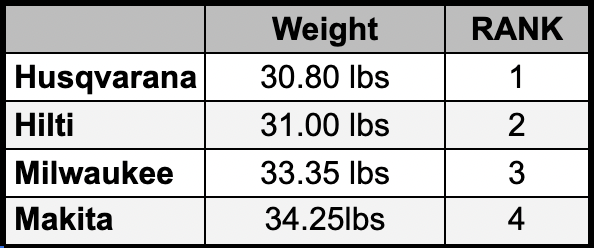
Note – the Husqvarna K770 gas saw has a weight of 26.12 lbs. without gas.
Best Concrete Cutter Battery Charging Time | Winner – Milwaukee and Hilti
In order to achieve gas saw performance you will need two sets of batteries. The theory is to have a battery(s) on the charger while you are working. This reduces downtime and maximizes your productivity. That being said, will the battery reach a full charge before you need it? The answer to that depends on how much cutting you are doing at one time.
The fastest battery charging time was a tie between Hilti and Milwaukee MX battery, both with charging times of 45 minutes. Its important to note that the Hilti ran off of two B22-255 batteries and to achieve this time you will need two chargers. Otherwise you’ll have to double this time.

Husqvarna was third with a 55 minute time, thanks to its “express charge” feature on the charger. This feature allows the user to press a button on the front of the charger to activate. However, you don’t want to fast charge batteries on a regular basis because it’s hard on the cells. A standard charge time is about 75 minutes. The express charge is there for when you need it. We are based in the North East USA and our electrical system is based on a 110V AC standard. Its important to note for European customers that the Husqvarna charger is able to perform slightly faster on the 220V AC standard and give a 45 minute express charge.
The Makita dual charger simultaneously charges both Makita 40V 8.0Ah batteries at the same time in 76 minutes.
Best Priced Power Cutter | Winner – Hilti
These four saws are unquestionably pricey tools. In order for these saws to achieve gas performance you will need two sets of batteries. Replacement blades on these machines runs approximately $150.
The Milwaukee and Makita saws are offered in a kit that includes two sets of batteries and a charger. The Milwaukee comes with two batteries, whereas the Makita comes with four (the saw requires two batteries to function).
Our conclusion is that these cut-off saws all require two batteries to match one tank of gas. For pricing we included the saw, two sets of batteries, and a charger for the Husqvarna and Hilti.
The winner of the best price is the Hilti DHS 700-22 priced in our kit form at $2,493.00
- Tool cost: $1,183.00
- 4 batteries: $243.00 each
- 2 chargers: $169.00 each
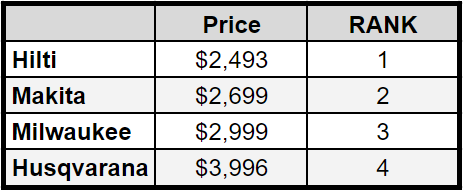
Second place was the Makita Power Cutter Kit totaling $2,699.00 and third was Milwaukee, sold as a kit for $2,999.00.
The most expensive cut off saw was the Husqvarna which when added all together was $3,996.00. This extremely high price is due to the cost of the batteries. The B750X battery is $939.00 each and when adding in two of them it contributes 50% of the total price. At this cost users could almost purchase two competitor saws for the price of the Husqvarna.
Overall Best 14″ Cordless Cut-Off Saw (Concrete Cutter) | Winner – Husqvarna
Its important to note that ALL of these cut-off saws performed well and were extremely close. Two of the manufacturers Hilti and Makita also have huge power tool platforms that their batteries will interchange with. The other two Husqvarna and Milwaukee, only have a few dozen tools currently that their batteries will power.
The overall Best Cordless Cut-Off Saw in our testing was the Husqvarna with a score of 21. Hilti came in second with 23 and Milwaukee just one point behind with 24.

Note: Given the number of categories scored for our overall ranking we decided to double the value of our performance tests. Both the Concrete Endurance and Rebar Speed scores were multiplied by a factor of 2 in the final chart. We feel that the cutting endurance and cutting power of these tools carry the most weight and importance to the potential end user.
The Hilti saw is technically a 12″ power cutter, had the shallowest depth of cut, but clearly punched above its weight in this test with a great feature set, low weight, and impressive run-time and speed scores.
The Husqvarna K1 Pace power cutter was a team favorite and a clear winner with top scores in five out of nine categories. It is a lightweight, well balanced cut off saw with great runtime, functionality and line of sight.
The Makita saw was heavy and powerful. It was the only saw we NEVER had to let up on and you can actually lean into cuts with. It has excellent features and ergonomics, a generous depth of cut and was second fastest in our metal cutting test.
The Milwaukee MX saw is a Gen 2 saw and was a speed demon when cutting metal averaging almost 3-seconds faster than the next concrete cutter. It too was a powerful cutter with an excellent depth of cut, great price with good features and ergonomics. The water connection issue hurt the MX saw and kept it from standing alone in 2nd place.
Best Value Cordless Concrete Cutter | Winner – Hilti and Milwaukee
Best value is typically awarded to the saw that performed well and is lowest or low in price. The Hilti and Milwaukee were close in scores and $500 apart in cost. With regard to performance the Milwaukee power cutter performed slightly better than the Hilti. One tool did well in concrete endurance, and the other in cutting speed.
The Hilti cordless cut-off saw surprised us all in its performance and frankly price. Hilti has historically been at the top of the pricing charts in all of our head-2-Head tests. The bottom line is both concrete cutters have great feature set, good ergonomics, and excellent charging times which is important to keep you in the “cutting” game.
Either of these cutters are great! ~ Rob
Closing Thoughts
The biggest issue with cordless cut-off saws is charge time. It’s our opinion that contractors who cut concrete with 2 tanks of gas or less a day are in the “sweet-spot” to convert to a battery power cutter. If you are cutting all day and using 5 to 7 tanks of gas you should stay with a gas cutter or invest in more batteries.
Speaking of batteries, the Hilti and Makita tools both use batteries that are compatible with a wide variety of smaller tools (Hilti’s Neuron line and Makita’s 40v XGT line). This could be a factor in purchasing decisions.
Lastly, charge time, and power to charge is a consideration. Many of these batteries require 45 minutes to charge, and you also need to consider how remote you are working. Do you have access to electricity or an inverter to charge your batteries?
We get lots of comments about how we make the final rankings. There are dozens of ways to compare tools, our goal when testing is to achieve repeatable, consistent results. We share ALL the data from our tests, so you can re-rank the tools however you want. If you don’t care about an item we ranked? No problem. Remove that from the matrix above and re-rank them.
Hopefully you’ll find this Head-To-Head useful when considering purchasing a larger cordless power cutter, or comparing them to gas models.
Please take some time and check out our other head-to-Head tests at ToolBoxBuzz.com.
Thanks, “the TBBCrew.”
Buy Now From Our Sponsored Retailers
Other Options
Best Cordless 14″ Cut-Off Saw (Concrete Cutter) | Video Review
About the author
Disclosure
Product reviews on this site contain our opinion of a product or service. We will always strive for objectivity and transparency in our reviews. Our goal is to provide readers with honest, objective information based on our own experiences. We never have and never will accept payment in exchange for a positive review. Many of the products that we review are provided to us for free by a manufacturer or retailer. In some cases, we also have advertising or affiliate relationships with manufacturers and retailers of products and services we review. For additional information please visit our additional disclosure policies.











